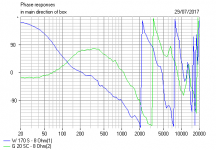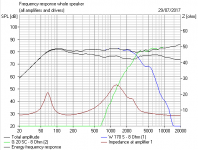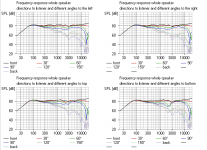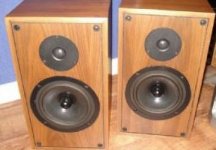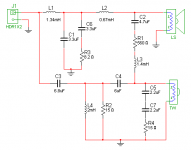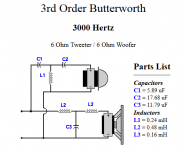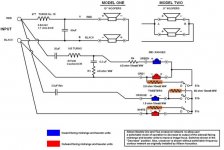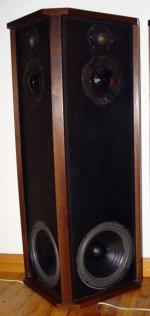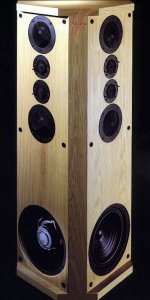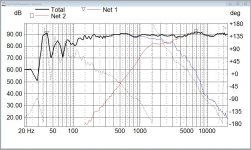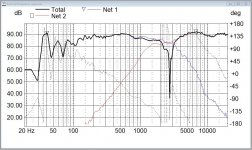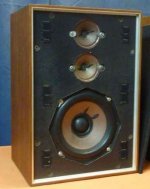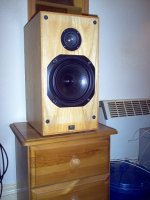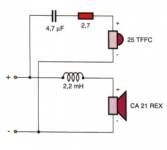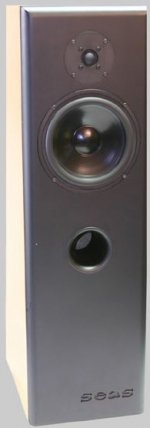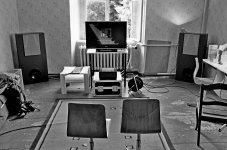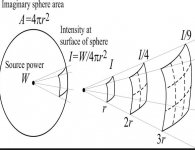My initial thought was: Wow, 96dB!
But, it is rated for 20 Watt
Nevertheless, these belong to the 'classic monitor' category.
That tweet resembles an oem Coles 4001 supertweeter.
It's a nice 5" speaker! Big box, isn't it? But I have decided that the 3kHz midrange shrieks. It's evident on the first two images of the sim. The impedance is dreadful too. Clarity Caps can't save me here.
I just checked my component box, and I have all the components to fix this. With and without impedance correction. Here's my plan... the second two images.
TBH, I suspect a flatter polycone 5" bass is easier than a paper 5" bass. Which might be all very BBC LS3/5A.
Attachments
-
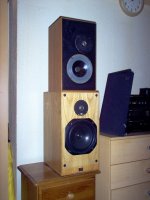 Monitor Audio R300-MD and MA7 (top).jpg77.7 KB · Views: 2,427
Monitor Audio R300-MD and MA7 (top).jpg77.7 KB · Views: 2,427 -
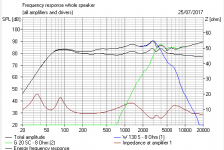 Monitor Audio MA7 simulated with MKP capacitors.PNG17.7 KB · Views: 1,567
Monitor Audio MA7 simulated with MKP capacitors.PNG17.7 KB · Views: 1,567 -
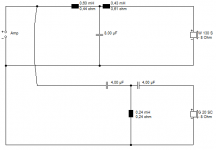 Monitor Audio MA7 crossover.PNG6.6 KB · Views: 2,002
Monitor Audio MA7 crossover.PNG6.6 KB · Views: 2,002 -
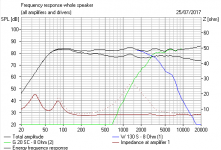 Monitor Audio MA7 New Crossover FR.PNG17.5 KB · Views: 686
Monitor Audio MA7 New Crossover FR.PNG17.5 KB · Views: 686 -
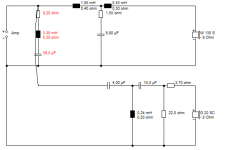 Monitor Audio MA7 New Circuit.PNG8.7 KB · Views: 2,052
Monitor Audio MA7 New Circuit.PNG8.7 KB · Views: 2,052 -
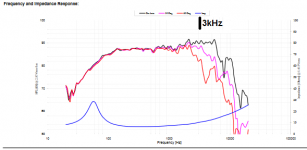 Peerless 830860.PNG28.3 KB · Views: 143
Peerless 830860.PNG28.3 KB · Views: 143 -
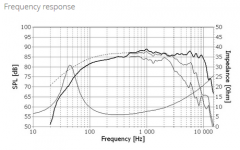 SEAS CA15RLY FR.PNG61.6 KB · Views: 90
SEAS CA15RLY FR.PNG61.6 KB · Views: 90
This is an interesting discussion on zobel networks:
Zobel network necessity | Audiokarma Home Audio Stereo Discussion Forums
I like the concept of high sensitivity woofers with low inductance and customized voice coils that result in linear impedance combined with a natural rolloff in the optimal xo range.
Zobel network necessity | Audiokarma Home Audio Stereo Discussion Forums
I like the concept of high sensitivity woofers with low inductance and customized voice coils that result in linear impedance combined with a natural rolloff in the optimal xo range.
Last edited:
We get an awful lot of questions about replacement drivers at diyaudio. And I always end up saying the same thing. Measure the flippin' baffle cutout and the impedance of the driver with a DC multimeter! It's not hard. But 90% of them just end up paying inflated prices on eBay for some ropey 40-y-o exact replacement. 
The 12L MA7 has an unusual 90mm tweeter cutout and 147mm bass cutout.
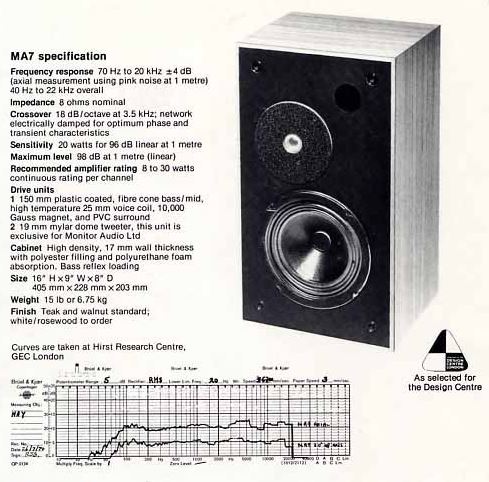
That might work well enough with a 6" driver. And in fact my new crossover idea works better with a 6" than with a 5" bass for a near perfect BW3. It's also stunningly close to the 14L closed box Peter Comeau designed Heybrook HB2 on slopes. We'd best ignore the slightly weird LCR which does almost nothing.
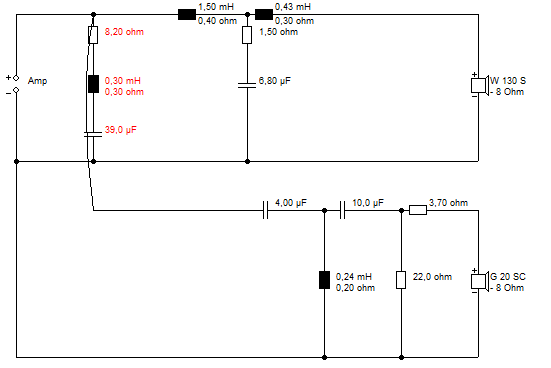
The Heybrook HB2 actually uses a flat 6" low Qts (say, 0.3) polycone in small closed box.
Vifa P17WJ-00-08 Woofer
Monacor SPH-165 Diameter 165mm
All the goodness of BW3 on dispersion. Something I like. BW3 works in either polarity. You get slightly less group delay and swapped lobing with one of them. But I can never remember which way round it is.
The 12L MA7 has an unusual 90mm tweeter cutout and 147mm bass cutout.
That might work well enough with a 6" driver. And in fact my new crossover idea works better with a 6" than with a 5" bass for a near perfect BW3. It's also stunningly close to the 14L closed box Peter Comeau designed Heybrook HB2 on slopes. We'd best ignore the slightly weird LCR which does almost nothing.
The Heybrook HB2 actually uses a flat 6" low Qts (say, 0.3) polycone in small closed box.
Vifa P17WJ-00-08 Woofer
Monacor SPH-165 Diameter 165mm
All the goodness of BW3 on dispersion. Something I like. BW3 works in either polarity. You get slightly less group delay and swapped lobing with one of them. But I can never remember which way round it is.
Attachments
I have to agree with you on the old/new part deal. Unless it is a museum piece, the potential for failure is not worth it. Even our dear departed Roy Allison said replace 'em in sets, and sell the leftovers to the restorers and fetishists. He always said they built their own drivers because it would drive up the price of the finished product to buy what he wanted, not that his drivers were more capable than anything else. The mids and tweeters looked different because of how they were made; he was always uncomfortable with ad copy and over the top descriptions, they did what he wanted, and it took four of each to make a pair of Ones, eight for his IC20 monsters, and he wanted people to actually be able to buy them.
When I got my current pair of Ones, there was a dead tweeter, and I happened to have a spare, but they are currently Unaffordium, so a side project is to make some mounting plates for more modern replacements for the mids and tweeters.
Remember, two kinds of people are the sad droopy guy moaning " I have a problemmm" and the one with his shoulders back and a spring in his step saying "I have a problem!"
At least we're not bored.
best, David
When I got my current pair of Ones, there was a dead tweeter, and I happened to have a spare, but they are currently Unaffordium, so a side project is to make some mounting plates for more modern replacements for the mids and tweeters.
Remember, two kinds of people are the sad droopy guy moaning " I have a problemmm" and the one with his shoulders back and a spring in his step saying "I have a problem!"
At least we're not bored.
best, David
I have some stuff on the Allison IC20, One and Two speakers. 
Roy Allison was one of the greats, of course. He and Edgar Villchur and Henry Kloss changed our perception of speakers.
A friend of mine used to have some tiny AR4 acoustic suspension speakers. They amazed me how loud they could go without distortion.
These wallmounted designs are genius, IMO. Low inductance woofers seem to be ideal for wallmounting, like current SB Acoustics, but need higher order filters to be well behaved. Of course, you need to know about the Allison effect on bass cancellation to really get it. But I love that MTTM style too. It's obviously a good way to do things.
In answer to Ro808 on impedance, there are good ways to get it good: Zobel and Bafflestep Correction, preferably around 3-4dB. Once you impedance correct a driver, you can use Butterworth Stock Values for a flat impedance if the driver is flat. And notice the 3:1 ratio at the heart of BW3. But bafflestep mucks it up slightly. But I doubt if Roy Allison's designs need bafflestep.
Roy Allison was one of the greats, of course. He and Edgar Villchur and Henry Kloss changed our perception of speakers.
A Glorious Time: AR's Edgar Villchur and Roy Allison | Stereophile.comAllison played a major role in the company's fortunes for several years before leaving in 1972, but more importantly, extended Villchur's idea of system engineering to one where a complete loudspeaker should not be designed without taking the properties of the listening room into account. —John Atkinson
A friend of mine used to have some tiny AR4 acoustic suspension speakers. They amazed me how loud they could go without distortion.
These wallmounted designs are genius, IMO. Low inductance woofers seem to be ideal for wallmounting, like current SB Acoustics, but need higher order filters to be well behaved. Of course, you need to know about the Allison effect on bass cancellation to really get it. But I love that MTTM style too. It's obviously a good way to do things.
In answer to Ro808 on impedance, there are good ways to get it good: Zobel and Bafflestep Correction, preferably around 3-4dB. Once you impedance correct a driver, you can use Butterworth Stock Values for a flat impedance if the driver is flat. And notice the 3:1 ratio at the heart of BW3. But bafflestep mucks it up slightly. But I doubt if Roy Allison's designs need bafflestep.
Attachments
Last edited:
I made a new version of the Arkadia with this woofer :
H1659-08 U22REX/P-SL
H1659-08 U22REX/P-SL
If anyone is interested, theclassicspeakerpages has the quick explanation of the Allison Effect in the Series One brochure, and the long version also, about 14 pages with lots of drawings and graphs. He made 'normal' looking speakers, too. His model of room behavior helped him avoid that dip you see even in some of Troels' in-room modeling graphs. Troels' 'almost in a corner' design is interesting, coming close to three boundaries, rather than getting right up against one or two(or three as in his Model Three). Henry Kloss' Six was meant to be set on the floor in most rooms, and often sounds funny to me when people put them on stands to get the tweeter height up to ear level.
Member
Joined 2009
Paid Member
If anyone is interested, theclassicspeakerpages has the quick explanation of the Allison Effect in the Series One brochure, and the long version also, about 14 pages with lots of drawings and graphs. He made 'normal' looking speakers, too. His model of room behavior helped him avoid that dip you see even in some of Troels' in-room modeling graphs. Troels' 'almost in a corner' design is interesting, coming close to three boundaries, rather than getting right up against one or two(or three as in his Model Three). Henry Kloss' Six was meant to be set on the floor in most rooms, and often sounds funny to me when people put them on stands to get the tweeter height up to ear level.
Here'a an actual link: Allison One Series Brochure (1978) | The Classic Speaker Pages
Interesting read. I notice a couple of things, a) try to put the difficult reflection modes above the woofer cross-over. Means having a low cross-over so you want at minimum a classic 3-way or FAST set-up, b) position the speaker(s) so that the reflection modes from adjacent room boundaries are at different path lengths, interference effects will then appear at different frequencies rather than stacking up.
Last edited:
Joachim, good to have you back! One of my audio heroes! 
Hope you've screwed your new design together better than the last Sonics Arkadia! Bigun thought it was rubbish. BTW, Bigun, me and Joachim get the Allison effect. It's floorbounce at heart. In my dreams I wallmount everything.
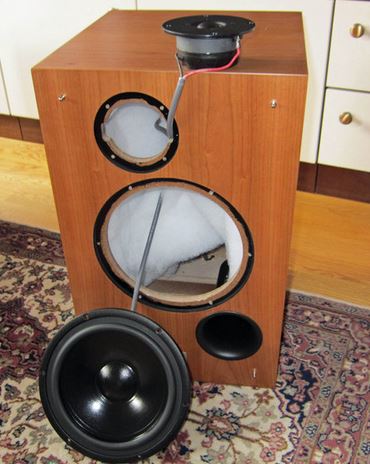
I did always like that SEAS U22 polycone. No dustcap! Low inductance. OK, a less than ideal lossy aluminium former, but whatever. And the DXT waveguide seems like a plan for a metal tweeter. I think wide dispersion is overrated. I still love my cheapie cone tweeters. But if one is good, maybe two is better?
The SEAS Njord seems like a speaker that launched a thousand ships. (Sorry to ramble...)
Hope you've screwed your new design together better than the last Sonics Arkadia! Bigun thought it was rubbish. BTW, Bigun, me and Joachim get the Allison effect. It's floorbounce at heart. In my dreams I wallmount everything.
I did always like that SEAS U22 polycone. No dustcap! Low inductance. OK, a less than ideal lossy aluminium former, but whatever. And the DXT waveguide seems like a plan for a metal tweeter. I think wide dispersion is overrated. I still love my cheapie cone tweeters. But if one is good, maybe two is better?
The SEAS Njord seems like a speaker that launched a thousand ships. (Sorry to ramble...)
Attachments
I, fortunately, don't have to make a living from this. What I do know, is that all speakers are compromise.
We get live bands, discos and brass bands and orchestras at work. There is absolutely nothing that can compare to the sound of live acoustic instruments in a big hall. Such dynamics!
But along with flat impedance, I really like the array idea with speakers.
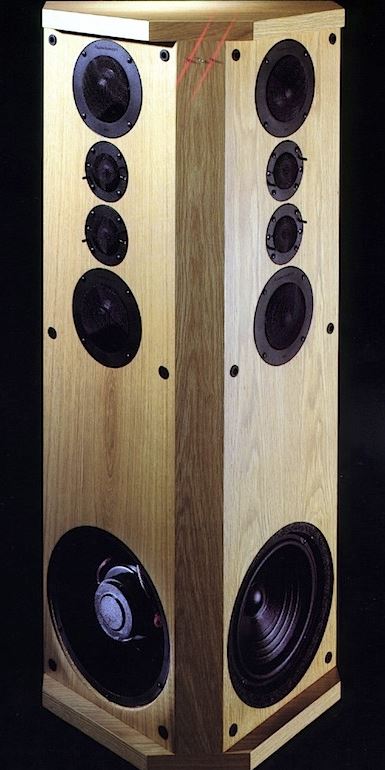
These babies just don't annoy the neighbours with high SPL. Because they focus the sound horizontally. Which is where we are listening. I always prefer discos with line arrays rather than the usual old MT active speaker.
We get live bands, discos and brass bands and orchestras at work. There is absolutely nothing that can compare to the sound of live acoustic instruments in a big hall. Such dynamics!
But along with flat impedance, I really like the array idea with speakers.
These babies just don't annoy the neighbours with high SPL. Because they focus the sound horizontally. Which is where we are listening. I always prefer discos with line arrays rather than the usual old MT active speaker.
That room could do with a woman's touch, IMO! 
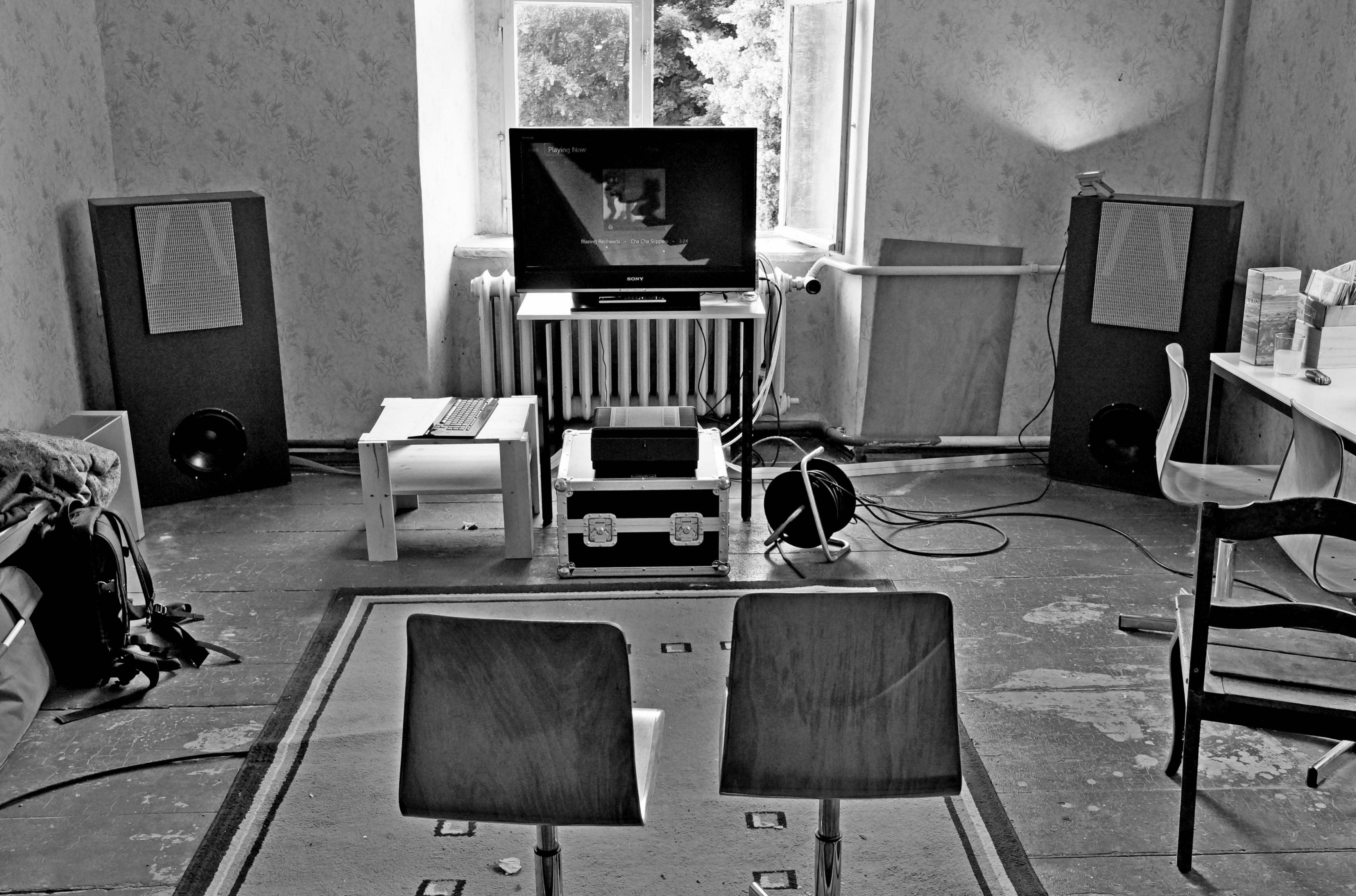
I was running with boswald's mention of Henry Kloss. I made a mistake thinking this was a KLH Model 6. In fact it's 30 years on with Cambridge Soundworks Model 6 designed by Henry Kloss. But he was still on the same track.
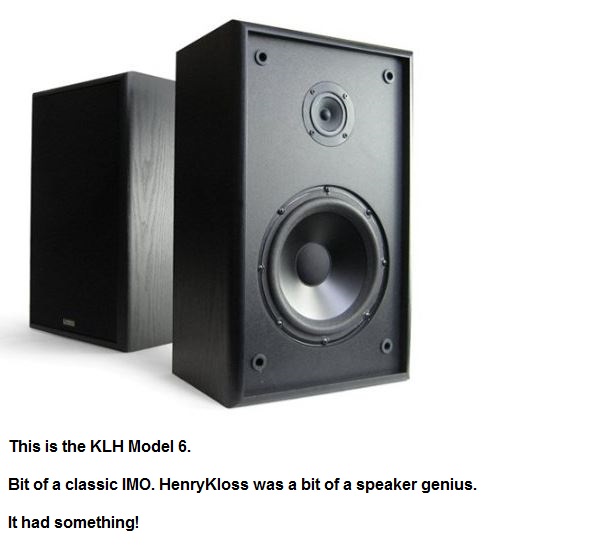
I have the installation manual in front of me. It is an 8" acoustic suspension bass (which means huge magnet motor and small closed box), and a 1 3/4" closed back cone tweeter with a butyl rubber surround, enabling it to cross at 2kHz without distortion issues. Generously, the speakers come with 8 free adhesive rubber feet and a recommendation of 18 swg speaker cable. No audio voodoo there!
I have frequently said I thought this marco_gea design was well executed. It's that little Monacor HT22 cone tweeter again. Crossed at 2.5kHz second order.
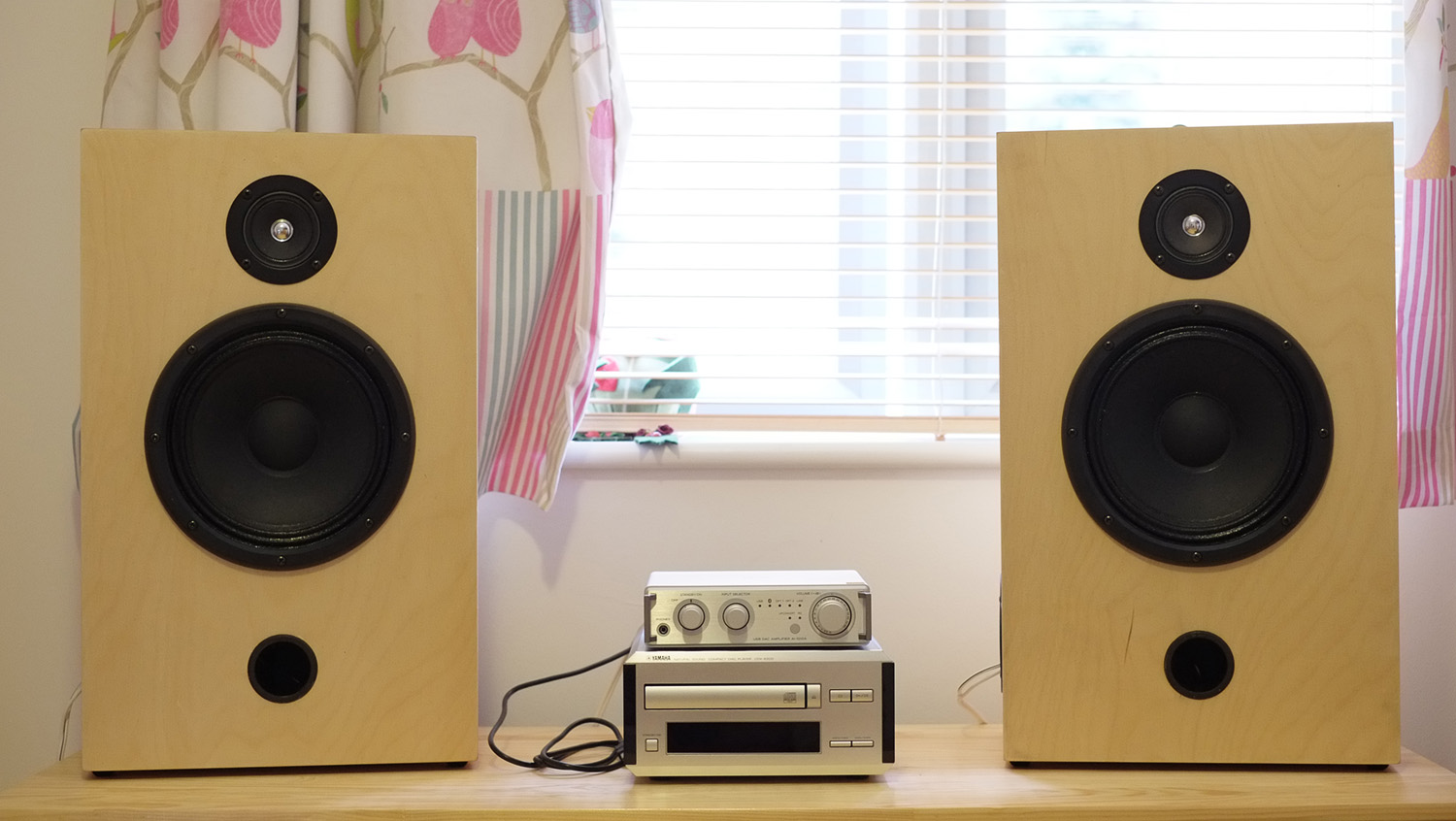
I built something similar, and a great lively sound it had, but I did feel the tweeter was struggling with the lowish crossover. I can think of some fixes for that. Just doubling the tweeters would be one. Which almost brings us back to the MTTM idea. It breaks the irritating inverse square spherical loudness thing into more of the gentler PA sound. My advice is never to get too close to an MT. It will shred your eardrums!
I was running with boswald's mention of Henry Kloss. I made a mistake thinking this was a KLH Model 6. In fact it's 30 years on with Cambridge Soundworks Model 6 designed by Henry Kloss. But he was still on the same track.
I have the installation manual in front of me. It is an 8" acoustic suspension bass (which means huge magnet motor and small closed box), and a 1 3/4" closed back cone tweeter with a butyl rubber surround, enabling it to cross at 2kHz without distortion issues. Generously, the speakers come with 8 free adhesive rubber feet and a recommendation of 18 swg speaker cable. No audio voodoo there!
I have frequently said I thought this marco_gea design was well executed. It's that little Monacor HT22 cone tweeter again. Crossed at 2.5kHz second order.

I built something similar, and a great lively sound it had, but I did feel the tweeter was struggling with the lowish crossover. I can think of some fixes for that. Just doubling the tweeters would be one. Which almost brings us back to the MTTM idea. It breaks the irritating inverse square spherical loudness thing into more of the gentler PA sound. My advice is never to get too close to an MT. It will shred your eardrums!
Attachments
- Home
- Loudspeakers
- Multi-Way
- Classic monitor designs?
